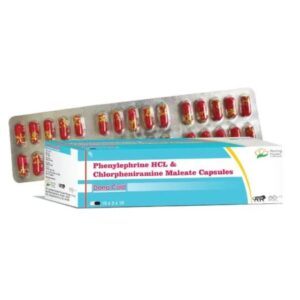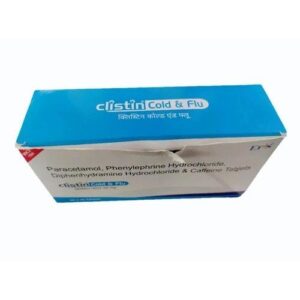CHLORPHENIRAMINE + PARACETAMOL (ACETAMENOPHEN) + GUAIPHENESIN + PHENYL PROPANOLAMINE
Chlorpheniramine: Chlorpheniramine is an antihistamine drug that is commonly used to treat allergies and common cold symptoms. It works by blocking the effects of the histamine, which is a chemical produced by the body during an allergic reaction.
This medication is available in various forms, including tablets, capsules, syrups, and injections. It can be used to relieve symptoms such as sneezing, runny nose, itchy or watery eyes, and itching in the throat or nose.
The typical adult dose of chlorpheniramine is 4 mg to 20 mg taken every 4 to 6 hours, with a maximum daily dose of 24 to 40 mg. The dose for children depends on their age and weight, and it should only be given under the guidance of a healthcare professional.
Despite its effectiveness in treating allergies, chlorpheniramine may cause some side effects. Common side effects include drowsiness, dizziness, dry mouth, blurred vision, and constipation. These side effects are usually mild and temporary. However, it is important to note that chlorpheniramine can cause significant drowsiness, so it is recommended to avoid activities that require alertness, such as driving, while taking this medication.
Less common but more serious side effects may include difficulty urinating, rapid or irregular heartbeat, confusion, and seizures. If any of these occur, it is important to seek medical attention immediately.
Chlorpheniramine is generally considered safe for most people when used as directed. However, it is important to consult with a healthcare professional before starting this medication to ensure it is appropriate for your specific condition and to discuss any potential drug interactions or contraindications.
Paracetamol (acetamenophen): Paracetamol, also known as acetaminophen, is a commonly used medication for pain relief and reducing fever. It is available over-the-counter and comes in various forms such as tablets, capsules, and liquid suspensions.
Mechanism of Action:
The exact mechanism of action of paracetamol is not fully understood. It is believed to work by inhibiting the production of certain chemicals called prostaglandins in the brain that are involved in the process of pain and fever. It is also thought to act on the heat-regulating center in the brain, which helps reduce fever.
Use:
Paracetamol is primarily used to relieve mild to moderate pain such as headaches, toothaches, muscle aches, arthritis, and menstrual cramps. It can also be used to reduce fever. It is important to note that paracetamol is not effective in reducing inflammation like other non-steroidal anti-inflammatory drugs (NSAIDs) such as ibuprofen.
Dose:
The recommended dose of paracetamol for adults is typically 500-1000 mg every 4-6 hours, not exceeding 4000 mg (4 grams) in a 24-hour period. The dosage may vary depending on the age, weight, and underlying health condition of the individual. It is important to read and follow the instructions on the packaging or consult a healthcare professional for proper dosing guidance.
Side Effects:
Paracetamol is generally considered safe when used as directed. However, like any medication, it can have side effects. Common side effects may include nausea, vomiting, upset stomach, and rash. In rare cases, it can cause serious allergic reactions or liver damage, especially when taken in excessive doses or used for extended periods. It is important to seek medical attention if any unusual or severe side effects occur.
Interactions:
Paracetamol can interact with certain medications such as blood thinners (e.g., warfarin), certain antidepressants, and some antibiotics. It is important to inform your healthcare provider about all the medications you are taking before using paracetamol to avoid any potential interactions or complications.
Precautions:
People with a history of liver disease or those who consume alcohol regularly should exercise caution when using paracetamol as it can further stress the liver. It is also not recommended to exceed the recommended daily dose or use it continuously for an extended period without consulting a healthcare professional.
Overall, paracetamol (acetaminophen) is a widely used and effective medication for pain relief and reducing fever. However, it is essential to use it as directed and seek medical advice if needed, especially if experiencing severe or prolonged symptoms.
Guaiphenesin: Guaifenesin is a medication commonly used to relieve symptoms of respiratory conditions such as cough and congestion. It is an expectorant, which means it helps to thin and loosen mucus in the airways, making it easier to cough up.
The exact mechanism of action of guaifenesin is not fully understood. It is believed to work by increasing the output of respiratory tract fluids, thereby reducing the viscosity of mucus in the airways. This helps to promote the removal of mucus and allows for easier breathing.
Guaifenesin is available in various forms such as tablets, capsules, syrups, and extended-release formulations. The appropriate dose and frequency of administration may vary depending on the specific product and individual requirements. It is important to carefully follow the instructions provided by your healthcare provider or as indicated on the packaging.
Common side effects of guaifenesin may include nausea, vomiting, dizziness, headache, and stomach upset. These side effects are usually mild and temporary. However, if you experience any severe or persistent side effects, it is important to seek medical attention.
It is essential to consult a healthcare professional before taking guaifenesin, especially if you have any pre-existing medical conditions or are taking other medications. They will be able to provide you with personalized advice and determine if guaifenesin is suitable for you.
Overall, guaifenesin is a widely used expectorant that helps relieve respiratory symptoms such as cough and congestion. It should be used as directed and any concerns or questions should be discussed with a healthcare provider.
Phenyl Propanolamine: Phenyl Propanolamine (PPA) is a sympathomimetic drug that was commonly used as a decongestant and appetite suppressant. However, it has been withdrawn from the market due to safety concerns.
PPA works by stimulating the adrenergic receptors, specifically the alpha-1 receptors, which causes vasoconstriction and an increase in blood pressure. It also acts as a norepinephrine reuptake inhibitor, leading to increased levels of norepinephrine in the brain. This combination of effects results in the narrowing of blood vessels and decreased congestion.
In terms of dosing, PPA was typically available in tablet or liquid form. The recommended dose varied depending on the specific product and indication. It is essential to follow the instructions provided by the healthcare professional or medication package.
Due to safety concerns, PPA has been withdrawn from the market in many countries. It has been associated with serious adverse effects, most notably an increased risk of stroke, especially in young women. Other potential side effects include increased heart rate, elevated blood pressure, headache, nausea, dizziness, anxiety, and insomnia.
Given the withdrawal of PPA from the market, it is crucial to consult a healthcare professional for alternative medications to address the specific conditions for which PPA was previously used.



